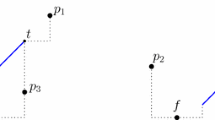Abstract
Facility location problems have always been studied with theassumption that the edge lengths in the network are static anddo not change over time. The underlying network could be used to model a city street networkfor emergency facility location/hospitals, or an electronic network for locating information centers. In any case, it is clear that due to trafficcongestion the traversal time on links changes with time. Very often, we have estimates as to how the edge lengths change over time, and our objective is to choose a set of locations (vertices) ascenters, such that at every time instant each vertex has a center close to it (clearly, the center close to a vertex may change over time). We also provide approximation algorithms as well as hardness results forthe K-center problem under this model. This is the first comprehensive study regarding approximation algorithmsfor facility location for good time-invariant solutions.
Similar content being viewed by others
References
J. Bar-Ilan, G. Kortsarz and D. Peleg, “How to allocate network centers,” J. Algorithms vol. 15, pp. 385-415, 1993.
S. Chaudhuri, N. Garg, and R. Ravi, “The p-neighbor k-center problem,” Information Processing Letters vol. 65, pp. 131-134, 1998.
Z. Drezner, “The p-centre problem-heuristic and optimal algorithms,” J. Opl. Res. Soc. vol. 35, pp. 741-748, 1984.
M. Dyer and A. M. Frieze, “A simple heuristic for the p-center problem,” Operations Research Letters vol. 3, pp. 285-288 1985.
M. R. Garey and D. S. Johnson, Computers and Intractability: A guide to the theory of NP-completeness, Freeman: San Francisco, 1978.
T. Gonzalez, “Clustering to minimize the maximum inter-cluster distance,” Theoretical Computer Science vol. 38, pp. 293-306, 1985.
R. Hassin, “Approximation schemes for the restricted shortest path problems,” Mathematics of Operations Research vol. 17, no.1, pp. 36–42, Feb. 1992.
D. Hochbaum and A. Pathria, “Locating centers in dynamically changing network and related problems,” Location Science, to appear.
D. Hochbaum and D. B. Shmoys, “A best possible heuristic for the k-center problem,” Mathematics of Operations Research vol. 10, pp. 180-184, 1985.
D. Hochbaum and D. B. Shmoys, “A unified approach to approximation algorithms for bottleneck problems,” Journal of the ACM vol. 33, no.3, pp. 533-550, 1986.
W. L. Hsu and G. L. Nemhauser, “Easy and hard bottleneck location problems,” Discrete Applied Mathematics vol. 1, pp. 209-216, 1979.
O. Kariv and S. L. Hakimi, “An algorithmic approach to network location problems. I: The p-centers,” SIAM J. Appl. Math vol. 37, pp. 513-538, 1979.
S. Khuller, R. Pless, and Y. J. Sussmann, “Fault tolerant K-Center problems,” in Proc. of the3rd Italian Conference on Algorithms and Complexity, LNCS 1203, 1997, pp. 37-48.
S. Khuller and Y. J. Sussmann, “The capacitated K-Center problem,” Proc. of the4th Annual European Symposium on Algorithms, LNCS 1136, 1996, pp. 152-166.
S. O. Krumke, “On a generalization of the p-center problem,” Information Processing Letters vol. 56, pp. 67-71, 1995.
H. L. Morgan and K. D. Levin, “Optimal program and data locations in computer networks,” Communications of the ACM vol. 20, pp. 315-322, 1977.
K. Murthy and J. Kam, “An approximation algorithm to the file allocation problem in computer networks,” in Proc. of the2nd ACM Symposium on Principles of Database Systems, 1983, pp. 258-266.
J. Plesnik, “A heuristic for the p-center problem in graphs,” Discrete Applied Mathematics vol. 17, pp. 263-268, 1987.
R. Ravi and M. X. Goemans, “The constrained minimum spanning tree problem,” SWAT 1996, pp. 66–75.
D. Serra and V. Marianov, “The P-median problem in a changing network: The case of Barcelona,” paper presented at the International Symposium in Locational Decisions VII, (ISOLDE), Edmonton, Canada, 1996.
C. Toregas, R. Swain, C. Revelle and L. Bergman, “The location of emergency service facilities,” Operations Research vol. 19, pp. 1363-1373 1971.
J. Van Leeuwen, Ed., Handbook of Theoretical Computer Science, Vol. A: Algorithms and Complexity, The MIT Press/Elsevier, 1990.
R. Panigrahy and S. Vishwanathan, “An O(log*n) approximation algorithm for the asymmetric p-center problem,” Journal of Algorithms vol. 27, pp. 259-268, 1998.
Q. Wang and K. H. Cheng, “A heuristic algorithm for the k-center problem with cost and usage weights,” in Proc. of the Twenty-Eighth Annual Allerton Conference on Communication, Control, and Computing, 1990, pp. 324-333.
A. Warburton, “Approximation of pareto optima in multiple-objective, shortest path problems,” Operations Research vol. 35, pp. 70-79, 1987.
Author information
Authors and Affiliations
Rights and permissions
About this article
Cite this article
Bhatia, R., Guha, S., Khuller, S. et al. Facility Location with Dynamic Distance Functions. Journal of Combinatorial Optimization 2, 199–217 (1998). https://doi.org/10.1023/A:1009796525600
Issue Date:
DOI: https://doi.org/10.1023/A:1009796525600




